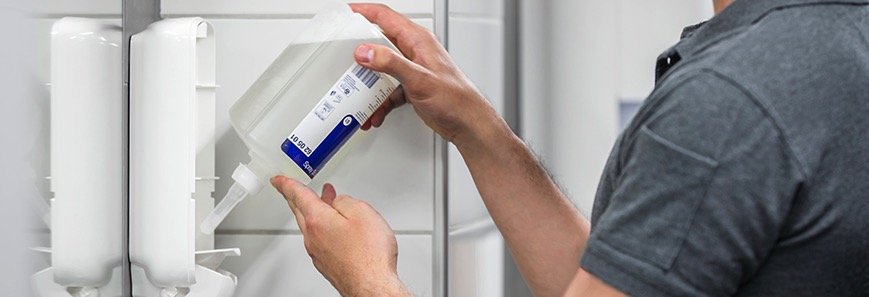In healthcare, the main method of hand hygiene is the use of alcohol-based hand sanitizer. Despite being an integral part of patient care and safety, there are two big challenges that reduce their use and increase the risk of cross contamination:
- The time pressures of healthcare workers to cover the distance to the dispensers and the time required to refill them.
- The use of open systems that can lead to cross-contamination.
Fortunately, Tork helps overcome these challenges with closed systems featuring our high-quality, hygienic sanitizer dispensers that can be refilled quickly.
Challenge #1: The time pressures in healthcare

Nurses and physicians have busy days and shifts caring for multiple patients. Because of time pressures, they may spend less time adequately sanitizing their hands between patients, especially when the distance to dispensers is not convenient. The risk of cross-contamination and the transmission of germs to patients increases if healthcare workers can’t reach dispensers in a timely way before, during or after seeing a patient.
Plus, the time pressures on nurses can be even greater during night and weekend shifts. During these times, nurses are often tasked with refilling dispeners instead of cleaning staff. When they don’t have enough time, empty dispensers and partly open bottles can compromise healthcare professionals, visitors and patients.
Solution: Sanitizing and refilling that saves time

Download a Tork dispenser placement guide for your specific healthcare area. Dispensers should be placed exactly where needed in the patient care workflow, such as next to every patient bed or exam table, to ensure healthcare workers have time to actually use the sanitizer. Dispensers should be visible in high-traffic areas and communication points about how to use the dispensers should be close by as well.
Tork dispensers are incredibly quick and easy to refill. Requiring as few as ten seconds, Tork solutions help save time for healthcare workers so sanitizer is always available and they can spend more time focused on patient care.
The refill process is simple:
- Turn the key to open dispenser
- Take out the empty refill pack
- Remove the seal from the new refill pack
- Insert new refill into dispenser
- Close and clean dispenser. Done!!
Challenge #2: Open systems lead to cross-contamination

Open systems are defined as a reservoir that is continually replenished with product through an opening in the container. On the other hand, the entire reservoir of a closed system is swapped out with a new sealed cartridge or container—so there’s no mixing of old and new sanitizer. When open system dispensers are left partly open—even while being refilled—airborne germs can enter the dispenser and contaminate the contents and subsequent users.
Solution: Only use closed systems and refills

The solution to the risks of open systems is to use only closed systems. Tork refills are sealed to help protect against cross-contamination. The risk of overfilling an open system and causing a mess or build-up is also eliminated by the use of closed systems.
Tork closed dispenser systems include:
- A sealed system helps protect from cross-contamination and offers confidence of high-level efficacy. Bottles are sealed during production to protect efficacy and quality of Tork soaps and sanitizers, all the way to the end user’s hands.
- A fresh bottle and pump with every refill.
- Easy to clean and easy to use dispensers that feature a push button to dispense soap or sanitizer.
- Additional hygienic options are available, including those with sensor dispensing.
Tork dispensers are ADA compliant, easy-to-use, easy-to-clean, and high-quality products for today’s demanding healthcare environments. Get a free trial of Tork Hand Sanitizers, specifically developed for demanding hygiene environments.
